|
1. Mating pair foraging for clams.
|
2. The stalker.
|
|
3. Let's run away!
|
4. Hot pursuit
|
|
5. Almost in the brush.
|
6. Where did they go?
|
When I visit the Alaska Peninsula I try to arrive during a time of low daytime tides, so the bears will come out and dig for clams. This is fine for me, because I can paddle around and take pictures from the relative security of my kayak or even the deck of my boat if I have placed the boat well.
But clamming is a risky business for the bears — they are in the open and visible, something bears are not happy about, and they can be attacked while preoccupied with digging up the beach. The set of pictures on this page shows a very large male bear stalking a mating pair who were no match for him. As usual, throughout the event I could see all the bears from my perspective on the water, but the bears could not see each other until the stalker had come within striking distance of his target.
It is important to understand that bears rely much more on smell and hearing than sight, only at relatively short ranges does sight comes into play. In this stalking event, the stalker came up from downwind, most likely relying primarily on smell to make his way to the goal, and also to avoid being sensed too soon by his prey.
When I saw this chase begin to unfold, I grabbed my camera and snapped a lot of pictures, perhaps overcompensating for the lost opportunity during "the kiss" described earlier. This is a great advantage of digital photography and large memory cards — you take a whole lot of pictures and discard 90% of them later.
The predator stealthily approached the mating pair, staying behind covering brush as much as possible, trying to get as close as possible without being detected. I assumed the stalking bear wanted to drive the male away and take the female for himself, something possible only because he was significantly larger than his prey.
In this case, however, the mating pair were very alert and, on sensing the approaching predator, took off with a startling burst of speed. I think the only reason they managed to escape the attacker is because they were able to move across relatively open terrain, while their attacker had to make his way through the stand of thick brush that had been concealing him from view. This delay prevented a confrontation at close quarters.
This chase clearly shows why it is unwise to move quietly through bear country. Bears are usually alert to the prospect of an attack and, if startled at close quarters, they must decide very quickly whether to run away or tear the attacker to pieces. When confronted by a human being — what a bear may see as a small, puny creature — he might think it simpler to swat the intruder with a paw than expend a lot of energy running away.
Although I don't go ashore on the Peninsula, I hike quite a lot in other parts of Alaska, and I try to make some noise as I walk along, to give the bears plenty of advance warning. While hiking this year, I had two close bear encounters, and both turned out very much as one would hope. On Bainbridge Island in Prince William Sound, while hiking back from a mountaintop, I got into some rather thick brush, very poor visibility, so I started making a lot of noise as I walked — "Hey, bear!", clapping my hands, that sort of thing — and pretty quickly came within about 50 feet of a bear. The bear quite obviously had been listening to my approach for a while and was not at all startled when I finally came into view — just as one would hope.
If this happens to you, whatever you do,
don't turn around, don't run away.
After admiring the bear for a while — he had that startlingly shiny, very black fur that some young black bears have — and only because he was smack in the middle of the trail I needed to use, I decided on a textbook approach. I waved my arms slowly above my head and said "Hey, bear!" in a relatively soft voice. This had precisely no effect — the bear was calm and curious, not at all inclined to leave. I was, after all, on his trail (most trails in this part of Alaska are bear trails, only sometimes used by humans) So I said, "I think you should GO!" with just that emphasis, and with that, the bear took off.
The other close encounter this season happened in Southeast Alaska, on another hike, another black bear. Even though I came within about the same distance as the account above, this bear wasn't on the trail, so I just walked past him. It was obvious that I had succeeded in alerting him to my presence well in advance, he gazed at me calmly as I approached, and he didn't seem disturbed by my passage, so I went on by. There was an element of mutual caution at work in this encounter: after I passed the bear, I looked over my shoulder every few seconds to make sure the bear wasn't pursuing me (one doesn't ever want to turn one's back on a bear or appear to be running away), and I could see he was doing the same thing — while foraging in the brush, every few seconds he would pop up and take a look at me.
Human/bear close encounters rely entirely on the bear falling for a bluff. The smallest adult bear could easily tear the largest human apart, after outrunning anyone foolish enough to try to run away, so there's no basis in reality for a human waving his arms around and acting like he's in charge. But with a reasonable amount of luck, the bear you meet won't know this. In the relatively wild places I choose for hikes, bears are not likely to have met a human before and don't know what to expect. So I pretend to be bigger and stronger, more in control of the situation, than is actually the case. And this is more or less the approach recommended by textbooks.
When I encounter a bear at close range, face to face, I feel a great sense of privilege. I know very well what kind of experience it is — it's an encounter between the earth's supposed dominant species, but who has unexpectedly and totally come to rely on the benevolence (or indifference) of a much stronger creature. You know you have to do the right things — there's no take-over, no dialing 911, no cavalry beyond the next hill. Very simply, it's you and the bear. In a larger sense it's an example, of which there are many in a life worth living, where you either get it right or you die.


 Share This Page
Share This Page

 Share This Page
Share This Page
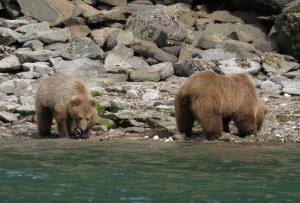
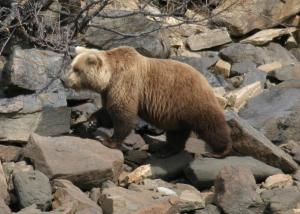
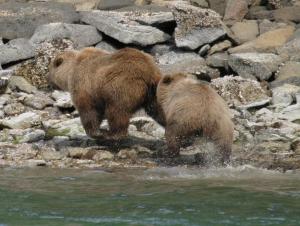
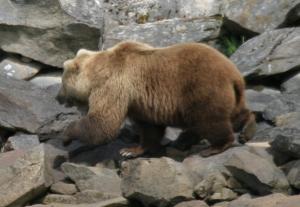
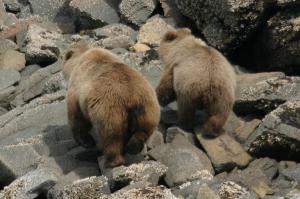
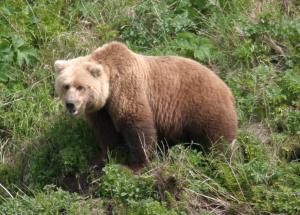
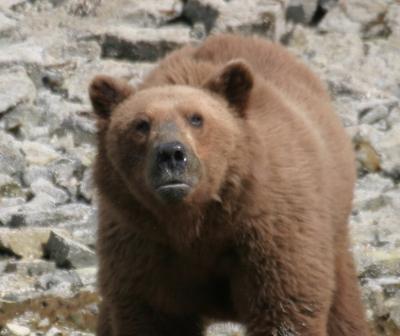


 Share This Page
Share This Page